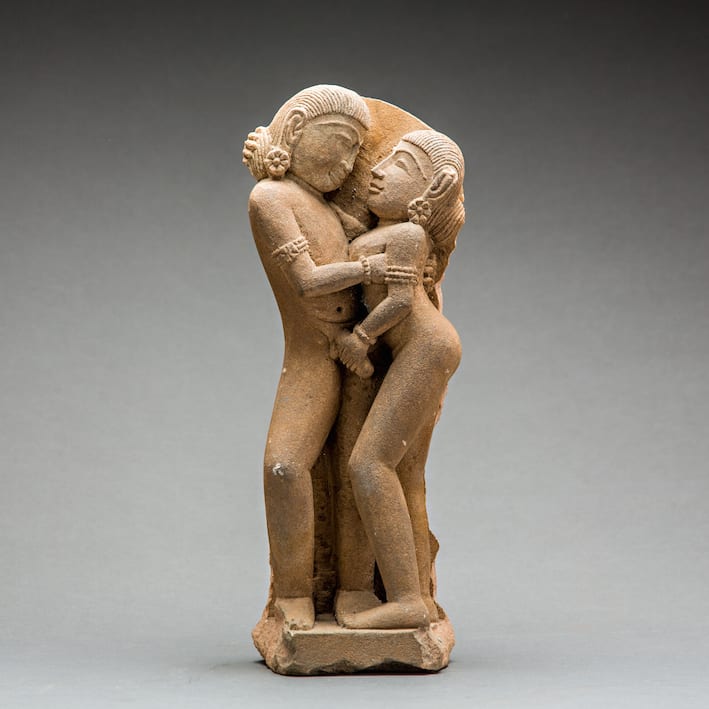Erotic Sandstone Sculpture of a Couple, 13th Century CE
Sandstone
height 29.5 cm
height 11 5/8 in
height 11 5/8 in
AM.0013
Further images
Once part of the decoration of the temple facade, this beautifully rendered sandstone sculpture represents two lovers in the early stages of their lovemaking and was made during the Eastern...
Once part of the decoration of the temple facade, this beautifully rendered sandstone sculpture represents two lovers in the early stages of their lovemaking and was made during the Eastern Ganga Dynasty of ancient India, and is based upon the Kama Sutra (see below). The position – both standing and embracing, the woman foldling the man’s membrum virile – is known as the Chest to Chest Embrace. The proportions are elongated and well-rendered. The facial expressions indicate gleeful anticipation and teasing. The detailing of hair, faces and jewellery on arms, ears and in the coiffures is exceptional.Their full bodies and detailed features are characteristic of architectural sculpture produced in thirteenth century Orissa, an Indian region noted for its temples, particularly those built between the 10th and 13th centuries. Couples such as the pair represented are believed to have several meanings, ranging from an obvious celebration of life's pleasures to the more metaphorical symbolism of a human soul's longing for union with the divine.
The Kama Sutra is commonly and mistakenly believed to be a lovers guide at best, pornography at worst. In fact, this epic work, written by Vatsyayana Mallanaga in the third century AD, is a very important work of scholarship that incorporates anthropology, sociology, psychology and philosophy as much as sexology. It is based upon standard philosophical principles. Many Indian philosophies are divided into the four main goals of life, to include Dharma (virtuous living), Artha (material prosperity), Kama (sensual pleasure) and Moksha (liberation). This holistic attitude towards life has stymied those who attempt to dismiss the Kama Sutra as indulgent pornography, although it is true that it is the somewhat graphic sexual images that have seen the greatest exposure and public popularity.
The Kama Sutra is divided into 1250 verses over 36 chapters. As stated above, many of these are comparatively mundane, featuring sections on personal motivation, manners, demeanour, business comportment, the importance of learning foreign languages and so forth. Further chapters include marriage and selection of a partner, civilities, appropriate social behaviour when with one’s spouse, and, eventually, sexual behaviour, fully illustrated to underline the practical issues and cosmological significances. Sex as part of the physicality that is a necessary part of life is underlined throughout, using parables from healthy and unhealthy social and sensual relationships to demonstrate the points made.
Ancient Indian artists often carved and painted the 64 sexual positions shown in the Kama Sutra, as these were considered to be perfectly valid as subjects, both aesthetically and philosophically. They were often arranged around the courtyards of temples and other public spaces in a frieze, and this is the likely source of the current piece. The Gupta period is noted for the fine quality of its carving, as can be clearly seen here.
Much of the relief works found on the outer walls of the Orissa temples has erotic sculptures. many are of opinion that such erotic sculptures are of indicative of the emergence of a phase the "tantrikism in Hinduism" at that time. The Maithuna ritual is depicted in the carvings of the temple. It is the most important of the five and constitutes the main part of the Grand Ritual of Tantra.
This is an impressive piece of ancient Indian art.
The Kama Sutra is commonly and mistakenly believed to be a lovers guide at best, pornography at worst. In fact, this epic work, written by Vatsyayana Mallanaga in the third century AD, is a very important work of scholarship that incorporates anthropology, sociology, psychology and philosophy as much as sexology. It is based upon standard philosophical principles. Many Indian philosophies are divided into the four main goals of life, to include Dharma (virtuous living), Artha (material prosperity), Kama (sensual pleasure) and Moksha (liberation). This holistic attitude towards life has stymied those who attempt to dismiss the Kama Sutra as indulgent pornography, although it is true that it is the somewhat graphic sexual images that have seen the greatest exposure and public popularity.
The Kama Sutra is divided into 1250 verses over 36 chapters. As stated above, many of these are comparatively mundane, featuring sections on personal motivation, manners, demeanour, business comportment, the importance of learning foreign languages and so forth. Further chapters include marriage and selection of a partner, civilities, appropriate social behaviour when with one’s spouse, and, eventually, sexual behaviour, fully illustrated to underline the practical issues and cosmological significances. Sex as part of the physicality that is a necessary part of life is underlined throughout, using parables from healthy and unhealthy social and sensual relationships to demonstrate the points made.
Ancient Indian artists often carved and painted the 64 sexual positions shown in the Kama Sutra, as these were considered to be perfectly valid as subjects, both aesthetically and philosophically. They were often arranged around the courtyards of temples and other public spaces in a frieze, and this is the likely source of the current piece. The Gupta period is noted for the fine quality of its carving, as can be clearly seen here.
Much of the relief works found on the outer walls of the Orissa temples has erotic sculptures. many are of opinion that such erotic sculptures are of indicative of the emergence of a phase the "tantrikism in Hinduism" at that time. The Maithuna ritual is depicted in the carvings of the temple. It is the most important of the five and constitutes the main part of the Grand Ritual of Tantra.
This is an impressive piece of ancient Indian art.





